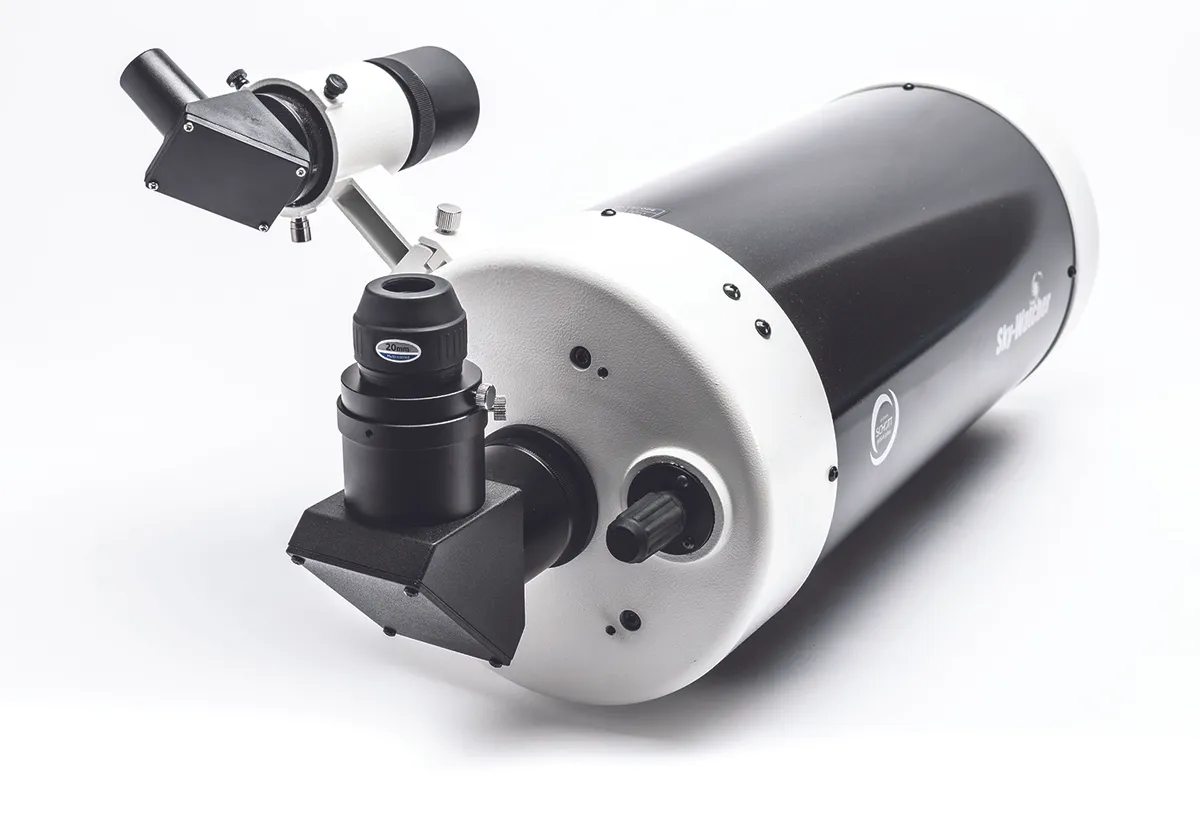The SkyMax 180 Pro is the largest in the Sky-Watcher range, yet despite its seemingly modest 7-inch mirror it punches above its weight.
Maksutov-Cassegrain telescopes employ mirrors and a front corrector lens to produce a compact, quite portable optical tube. This form of optical arrangement makes this a catadioptric or compound telescope.
Early models were painted gold and white, and were supplied with two 1.25-inch eyepieces and a straight-through finder.
For the SkyMax 180 Pro, Sky-Watcher has altered the colour scheme to a fetching black on diamond effect, updated the glass in the optics, changed the finder to a 9x50 right-angled variant and now only supplies one eyepiece, a 28mm long eye relief model with twist-up eyecup – however, the review scope was supplied with two 1.25 inch eyepieces (20mm and 9mm).
Completing the package is a star diagonal and a Vixen-style mounting bar.
Since 2008, Sky-Watcher has used Schott optical glass in its higher-end Pro series telescopes, and it is used again in the SkyMax 180 Pro.
The secondary mirror is integrated into the front corrector plate and produces a smaller secondary obstruction compared with some similar sized telescopes.
The focal length of 2,700mm folds into a tube only 500mm long (though there is a back tube extension of 60mm). Along with a tube width of 216mm, it really is quite compact.
At just 7.8kg too, it is also relatively lightweight for its size. Our EQ5 SynScan mount could handle it, but we found the larger NEQ6 mount offered the best performance.
This telescope features in our guide to the best telescopes for observing planets

Finding our way
The long focal length is ideal for planetary and lunar viewing, but this instrument also gives good views of many deep-sky objects.
The right-angled finderscope gives a 9x magnified view of the sky and many of the brighter deep-sky objects are visible in it, making locating them and finding alignment stars that much easier.
Using the 20mm eyepiece we checked the field of view for quality and were rewarded with a sharp view of the bright star Altair (Alpha Aquilae) across almost 90% of the view, with only the slightest distortion in the star visible at the edges.
Turning our sights farther afield, we enjoyed very good views of several popular targets such as the Dumbbell Nebula in Vulpecula, The Ring Nebula in Lyra and open cluster M39 in Cygnus – the latter more than filled the field of view the 20mm eyepiece gave.
Globular cluster M13 in Hercules was impressive, with multitudes of stars crowding its centre and the famous dark feature known as the Propeller easily visible.
The double star Albireo (Beta Cygni) was a treat with its golden yellow primary and pale sky-blue companion in the 20mm eyepiece, while with the 9mm eyepiece we were able to split the tight triple star Iota Cassiopeiae before morning twilight overcame it.
Saturn was lovely, with the Cassini Division, a dusky band on the disc and a polar region all on show.
We also saw several of the brighter moons in spite of the planet’s low declination by swapping in our own 26mm 1.25-inch eyepiece and boosting magnification with a 3x Barlow lens.
Attaching our own DSLR, we captured views of the Moon and could take long, tracked exposures of a number of deep-sky objects, revealing this instrument is not just good for visual observing, but also capable of deep-sky astrophotography.

Optics
The optical configuration is of a spherical primary mirror at the back with a corrector plate at the front, which also has a secondary silvered ‘spot’ on the convex side of the corrector. Sky-Watcher uses Schott glass for the optical elements and high-transmission multicoatings on all optical surfaces.
Compact body
The body weighs 7.8kg, while the optical design folds the light path to deliver a 2,700mm focal length in a tube just 500mm long. It attaches to a mount via a Vixen-style dovetail bar.
Eyepiece and star diagonal
The SkyMax 180 Pro is supplied with a 2-inch-fit star diagonal with a 2-inch to 1.25-inch adaptor. Though our review scope was supplied with 20mm and 9mm 1.25-inch eyepieces, in the future this instrument will be packaged with a single 28mm 2-inch LET (long-eye relief, twist-up eyecup) eyepiece.
Finder
The original finder supplied with gold-coloured SkyMax 180 Pro was a straight-through variant. This has been replaced with a 9x50 right-angled view finderscope, which is far more user friendly and easily adjustable to line up with the main optical axis.
Focuser
The focuser takes the form of a rotatable knob located at the back of the telescope. The mechanism was smooth in operation and had plenty of range to accommodate a star diagonal and eyepieces, but there was a little play in the system.
Vital stats
- Price £829
- Optics Maksutov-Cassegrain
- Aperture 180mm (7.1 inches)
- Focal length 2,700mm (f/15)
- Weight: 7.8kgs
- Focuser Movable primary mirror via rear knob
- Extras 9x50 finderscope, 2-inch fit star diagonal, 2-inch to 1.25-inch adaptor, 2-inch, 28mm long eye relief eyepiece, Vixen-style mounting bar
- Supplier Optical Vision
- Tel 01359 244 200
- www.opticalvision.co.uk
This review originally appeared in the September 2015 issue of BBC Sky at Night Magazine.
